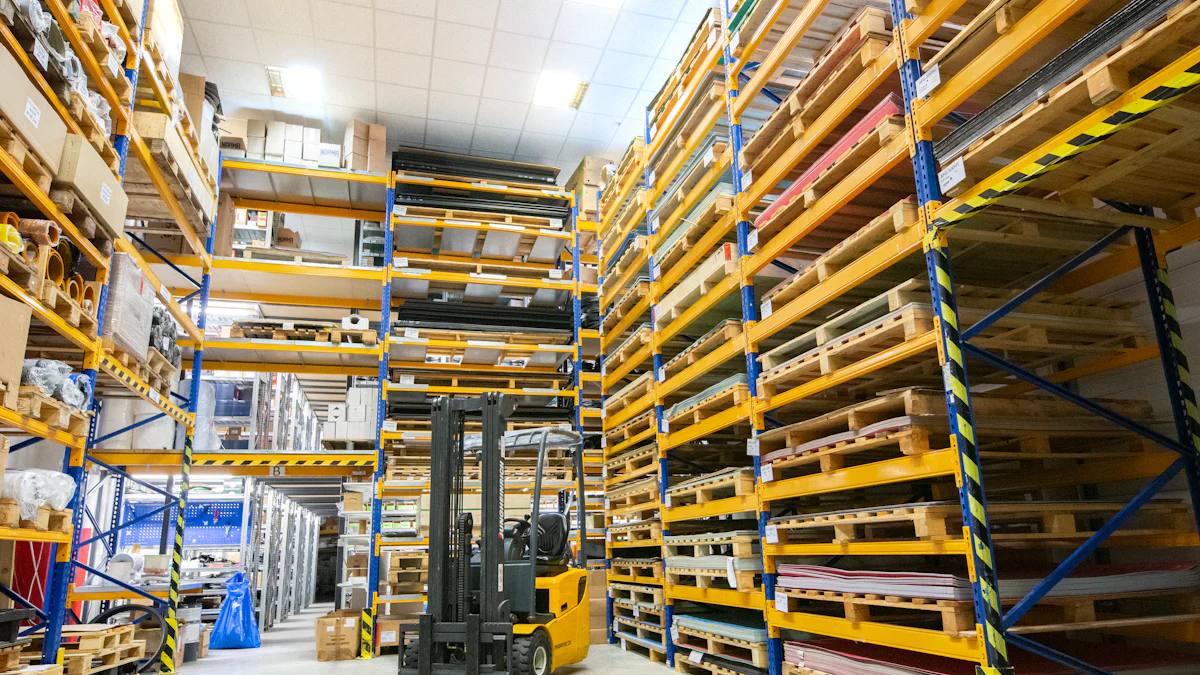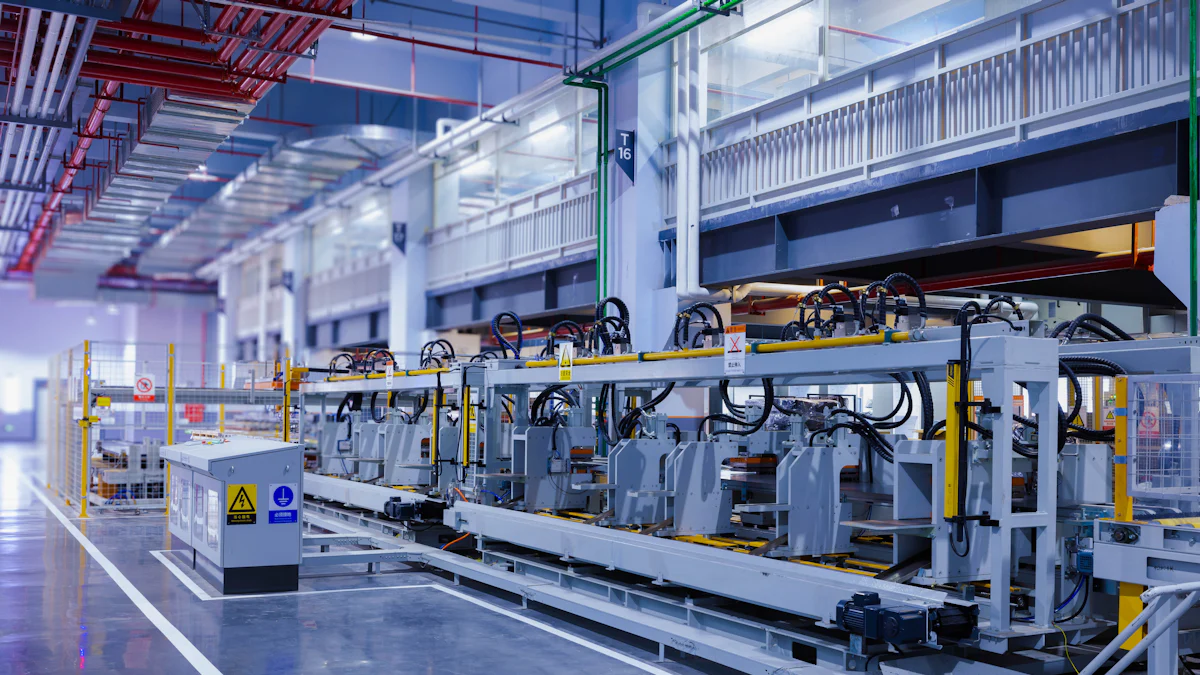Implementing Automated Warehousing: Key Considerations

Automation transforms warehousing into a marvel of efficiency. The magic lies in automated systems that boost productivity by 25% and improve space usage by 20%. These systems also enhance stock use efficiency by 30%. Modern warehousing thrives on automation, reducing labor costs by up to 60% and operational costs by 30%. Technological advancements make this possible, increasing picking accuracy to an astounding 99.99%. Automated warehousing offers a cost-effective alternative to large workforces. The stage is set for exploring key considerations in implementation.
Benefits of Automated Warehousing

Increased Efficiency
Automated warehousing transforms operations into a symphony of speed and precision. Faster processing times become the norm as automated systems optimize routes and maximize productivity. Imagine a warehouse where every item finds its place almost instantaneously. The magic lies in the technology that speeds up order fulfillment, leaving traditional manual operations in the dust.
Reduced human error is another marvel of automated warehousing. Machines don't forget or misplace items. The accuracy of automated systems reaches levels that humans can only dream of. The reduction in errors not only saves time but also enhances customer satisfaction. In the world of warehousing, precision reigns supreme.
Cost Savings
Automated warehousing slashes labor costs like a skilled swordsman. The need for a large workforce diminishes as machines take over repetitive tasks. Labor cost reduction becomes a reality, freeing up resources for other strategic endeavors. Businesses find themselves with more funds to invest in growth and innovation.
Energy efficiency shines brightly in automated warehousing. Systems operate with precision, minimizing waste and optimizing energy use. The result is a leaner, greener operation that benefits both the bottom line and the environment. Energy-efficient practices become second nature, leading to significant savings over time.
Improved Inventory Management
Real-time tracking becomes the heartbeat of automated warehousing. Every item, every movement, every transaction is monitored with laser-like focus. The ability to track inventory in real-time provides businesses with unparalleled visibility. This transparency leads to better decision-making and improved operational efficiency.
Better demand forecasting emerges as a powerful ally in automated warehousing. With accurate data at their fingertips, businesses can predict trends and adjust strategies accordingly. The days of overstocking and understocking fade into memory. Automated systems empower businesses to meet customer demands with precision and confidence.
Understanding User Needs
Identifying Warehouse Requirements
Size and layout considerations
Warehouse size plays a crucial role in automation success. A large warehouse may require more complex systems. A smaller space might need a different approach. Warehouse layout affects efficiency. A well-planned layout reduces travel time for automated systems. Efficient layouts maximize storage and streamline operations. A cluttered or poorly organized space hinders productivity.
Type of goods stored
The type of goods stored influences automation choices. Perishable items need different handling than non-perishables. Fragile goods require careful consideration. Automated systems must accommodate these needs. Heavy or bulky items may need specialized equipment. Understanding the nature of stored goods ensures optimal system design.
Assessing Current Operations
Workflow analysis
Workflow analysis reveals operational strengths and weaknesses. An efficient workflow boosts productivity. An inefficient one causes delays and errors. Managers should examine each step of the process. Identifying areas for improvement leads to better automation outcomes. Streamlined workflows enhance overall efficiency.
Bottleneck identification
Bottlenecks slow down operations. Identifying them is essential for smooth automation. Managers must pinpoint where delays occur. Addressing these issues improves system performance. Removing bottlenecks increases throughput. A seamless operation results in higher customer satisfaction.
Exploring Automation Solutions

Automated warehousing offers a treasure trove of technological wonders. The journey begins with the exploration of various automation technologies. Each technology holds the potential to revolutionize operations and elevate efficiency to new heights.
Types of Automation Technologies
Robotics
Robots in automated warehousing resemble tireless workers. These mechanical marvels perform tasks with precision and speed. Robots lift heavy loads, sort items, and even pack boxes. The use of robotics reduces the reliance on human labor. This shift addresses labor shortages and rising wages. Businesses witness a transformation as robots take over repetitive tasks. The warehouse floor becomes a dance of efficiency and productivity.
Automated Storage and Retrieval Systems (AS/RS)
Automated Storage and Retrieval Systems (AS/RS) serve as the backbone of automated warehousing. These systems store and retrieve goods with remarkable accuracy. AS/RS eliminates the chaos of misplaced items. The system ensures that every item finds its rightful place. Businesses benefit from reduced operating costs and improved inventory management. The integration of AS/RS transforms warehouses into organized havens of efficiency.
Software Solutions
Software solutions bring intelligence to automated warehousing. These digital wizards orchestrate operations with finesse. The right software solution can elevate a warehouse to new heights of efficiency.
Warehouse Management Systems (WMS)
Warehouse Management Systems (WMS) act as the brain of automated warehousing. These systems manage inventory, track orders, and optimize workflows. WMS provides real-time data that empowers decision-making. Businesses gain insights into their operations, leading to improved productivity. The implementation of WMS ensures that every aspect of the warehouse operates harmoniously.
Integration with Existing Systems
Integration with existing systems enhances the magic of automated warehousing. Seamless integration ensures that all components work together effortlessly. Businesses achieve optimal efficiency through this harmony. The integration process requires careful planning and execution. The result is a symphony of technology that elevates operations to new heights.
Automated warehousing stands as a beacon of innovation. The exploration of automation solutions reveals a world of possibilities. Each technology and software solution contributes to a seamless operation. Businesses that embrace these solutions unlock the full potential of their warehouses.
Planning and Design
Designing the Automated System
Layout planning
Warehouse layout planning resembles a grand puzzle. Each piece must fit perfectly to create a masterpiece of efficiency. A well-designed layout minimizes travel time for automated systems. The result is a streamlined operation that hums like a finely tuned orchestra. Every shelf, aisle, and corner plays a role in this symphony of productivity.
A cluttered warehouse disrupts the harmony. Items scattered haphazardly create chaos. Automated systems thrive in organized environments. A clear path ensures smooth operations. The layout becomes a silent conductor, guiding machines to their destinations with precision.
Equipment selection
Selecting equipment for an automated warehouse feels like choosing instruments for a band. Each piece must complement the others to create a harmonious performance. The right equipment enhances efficiency and reduces errors. Machines designed for specific tasks perform with grace and accuracy.
Heavy lifting requires robust machinery. Fragile items demand gentle handling. Equipment must match the nature of the goods stored. The careful selection process ensures that each machine plays its part flawlessly. The warehouse becomes a stage where technology takes center stage.
Budgeting and Cost Analysis
Initial investment
The initial investment in automated warehousing resembles planting seeds for future growth. The upfront costs may seem daunting. However, the potential returns make the investment worthwhile. Businesses allocate funds for technology, equipment, and training. The foundation laid during this phase supports long-term success.
Automation reduces labor costs significantly. The need for a large workforce diminishes as machines take over repetitive tasks. Businesses witness a transformation as automation slashes operational expenses. The initial investment sets the stage for a leaner, more efficient operation.
Long-term savings
Long-term savings in automated warehousing resemble a treasure chest waiting to be unlocked. Energy-efficient systems minimize waste and optimize resource use. The result is a greener operation that benefits both the environment and the bottom line. Businesses enjoy reduced energy bills and increased sustainability.
Real-time tracking and improved inventory management lead to better decision-making. Businesses avoid costly mistakes like overstocking or understocking. The ability to forecast demand accurately enhances profitability. Automated warehousing becomes a wise investment that pays dividends over time.
Implementation and Testing
Step-by-Step Implementation Process
Installation phases
The installation of automated warehousing systems resembles a well-orchestrated performance. Each phase unfolds with precision and purpose. The first step involves setting up the infrastructure. Technicians install the necessary hardware and software components. This foundation supports the entire operation. Next, the team configures the systems to align with warehouse needs. The configuration ensures that every component functions harmoniously. Finally, the testing phase verifies that each system operates as expected. The team conducts thorough checks to guarantee optimal performance.
Staff training
Staff training plays a crucial role in the success of automated warehousing. Employees must understand how to interact with new technologies. Training sessions provide hands-on experience with the systems. Workers learn to navigate interfaces and troubleshoot common issues. This knowledge empowers staff to work confidently alongside machines. Training also fosters a culture of innovation and adaptability. Employees embrace change and contribute to the warehouse's success.
Testing and Optimization
Performance testing
Performance testing in automated warehousing resembles a rigorous workout. The systems undergo stress tests to evaluate their capabilities. Technicians monitor how well the systems handle peak loads. This testing identifies any weaknesses or bottlenecks. The goal is to ensure that the warehouse operates smoothly under all conditions. Performance testing provides valuable insights into system efficiency. Businesses use this information to make informed decisions about improvements.
Continuous improvement strategies
Continuous improvement strategies keep automated warehousing at the forefront of innovation. Businesses regularly assess system performance and identify areas for enhancement. This proactive approach leads to ongoing optimization. Companies implement updates and upgrades to stay competitive. The focus remains on maximizing efficiency and minimizing costs. Continuous improvement ensures that automated warehousing evolves with changing demands. Businesses maintain a competitive edge by embracing innovation.
Automated warehousing transforms operations into a seamless symphony. The implementation process requires careful planning and execution. Each step contributes to the overall success of the warehouse. Testing and optimization ensure that systems operate at peak performance. Businesses that invest in these processes unlock the full potential of automated warehousing. The future of warehousing shines brightly with innovation and efficiency.
Automated warehousing offers a world of opportunities for businesses seeking efficiency. Key considerations include understanding user needs, exploring automation solutions, and meticulous planning. Thorough testing ensures optimal performance. The future of automated warehousing promises even greater advancements. JUSDA plays a pivotal role in this evolution. JUSDA's clients experience enhanced efficiency and reduced costs.
Supply Chain Manager, Client A: The partnership with JUSDA has transformed our supply chain operations significantly. We now operate with greater agility, reduced costs, and improved customer satisfaction.
JUSDA's flexible warehouse capacity meets diverse needs. Tailored storage options, including temperature-controlled facilities, enhance client satisfaction.
See Also
Maximizing Efficiency: Exploring Robotics in Warehouse Operations
Harnessing Logistics Robotics: Boosting Warehouse Efficiency
The Importance of Warehouse Automation for Business Success
Automating the Future: Advantages of High-Tech Manufacturing Warehouses
Mastering Lean Logistics for Success in High-Tech Manufacturing
